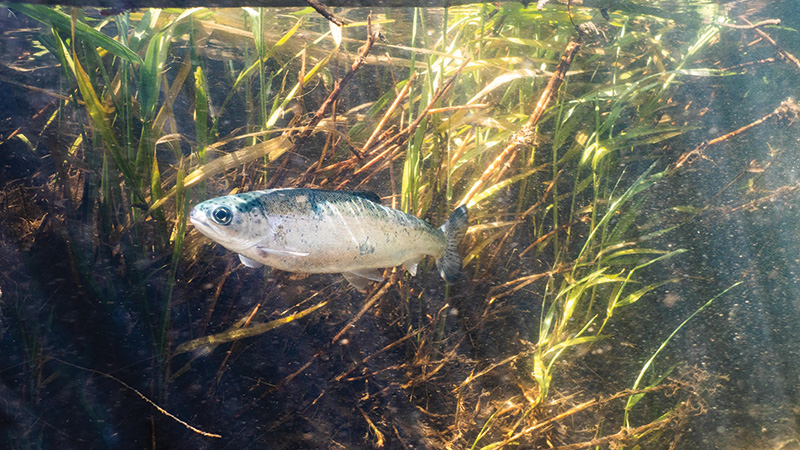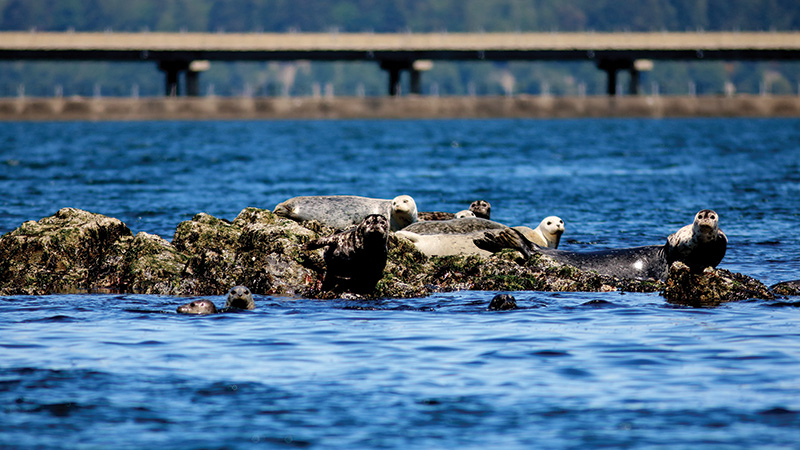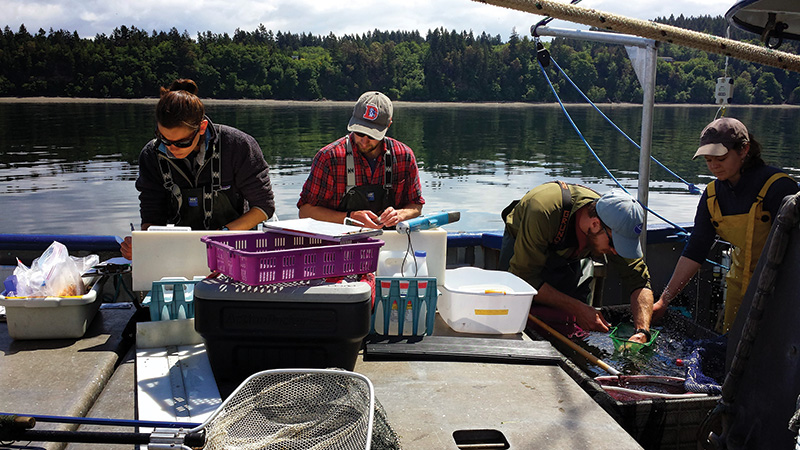A major study on salmon survival provides new answers
By Emily McCartan, guest contributor
This article was originally published in March 2022

Photos courtesy of Long Live the Kings
A decade-long study has provided major insights into the crisis of falling salmon and steelhead populations in the Salish Sea.
The Salish Sea Marine Survival Project involved more than 200 scientists from over 60 organizations from the U.S., Canada and Tribal nations in a collaboration led by Long Live the Kings (LLTK) in the U.S. and the Pacific Salmon Foundation (PSF) in Canada. The goal was to learn why so many juvenile salmon and steelhead from Salish Sea rivers are dying before they reach the open ocean. The final report gives the first ecosystem-wide understanding of the challenges salmon encounter as they enter the Salish Sea. It also lays out essential tools and strategies to guide the future of salmon recovery and management.
A dangerous trend
Since time immemorial, the inland marine waters from the Strait of Georgia to Puget Sound supported salmon populations of remarkable abundance. Salmon are at the heart of Northwest culture for Tribal and non-Tribal communities, critical to a $1.5 billion fishing industry, and a vital link in the food web for orca whales and over 130 other species. But since the 1970s, the productivity of Salish Sea Chinook, coho and steelhead have crashed, with some populations at 10% of their historical levels.
Without thriving salmon populations, “the culture, economy and ecosystems that support our coastal communities in the Pacific Northwest are in danger,” says Jacques White, executive director of Long Live the Kings. “Declining salmon runs threaten to breach the obligations made to Native American peoples and could push Southern Resident killer whales toward extinction.”
“The difference between 1% of juvenile salmon surviving, versus 3-5%, has a tremendous effect on the number of adults that come back.”
“Marine survival” refers to the number of salmon that survive the migration from river to ocean, returning to be caught in fisheries or spawn the next generation. For a short time after entering seawater, juvenile salmon enter a critical period that plays a major role in this long-term survival rate. Unlike fish from coastal rivers, salmon and steelhead born in the Puget Sound basin must make this transition while migrating through the unique dangers of the Salish Sea, before they can reach the open ocean. Mortality in these early months is always huge, but the difference between 1% of juvenile salmon surviving, versus 3-5%, has a tremendous effect on the number of adults that come back.
Understanding what influences salmon survival in this complicated ecosystem, however, required unprecedented collaboration at an international scale. In 2012 PSF and LLTK convened leading scientists to begin framing an ambitious transboundary research project. Its shared goal was to identify which factors are driving down early marine survival for Salish Sea salmon and steelhead, and to inform the urgent efforts on both sides of the border to recover them.

Findings from a changing ecosystem
Between 2014 and 2019, participating researchers sampled plankton, investigated the stomach contents of juvenile salmon, tracked the movements of seals and fish, and studied habitat, migration barriers, disease and pollution. The conclusions of the final Synthesis Report, published in 2021, identified the following key factors behind declining marine survival:
Changing food supply: Juvenile salmon are not finding enough of the right food at the right time, thanks to changing climate and marine conditions affecting plankton and forage fish at the base of the food web. As climate change intensifies these trends, recovering forage fish populations and continued ecosystem monitoring are essential for sustainable salmon runs.
More predators: Increasing numbers of predators like harbor seals are eating many salmon and steelhead, especially at migration barriers or when other fish populations like herring and anchovy are low. As a result of the Marine Survival Project, LLTK is already working with partners on solutions for predator “hot spots” where human infrastructure has created barriers for migrating fish, such as the Hood Canal Floating Bridge and Seattle’s Ballard Locks.
Local environmental challenges: Additional factors like pollution, disease, and loss of estuary and nearshore habitat are important to whether young fish are healthy enough to survive the challenges waiting for them in salt water. These factors overlap and build on each other. A fish carrying pollutants from its birth river, through a heavily developed estuary with little nutritious food available, in a year with few herring available for seals to eat, faces tremendous hurdles to survival. Habitat restoration and improvements in water quality and fish health remain crucial strategies to give salmon their best chance.

Collaborative research, collective action
“The Salish Sea Marine Survival Project showed us how invaluable cooperative, transboundary research networks are for salmon and ecosystem recovery,” says LLTK’s White. As the project partners move to put the findings into action, collaborative ecosystem science networks are essential to recovering salmon in the face of climate change in a rapidly growing region. Long Live the Kings has recently helped secure funding for U.S. participation in an international expedition this winter to study salmon in the North Pacific Ocean, the next destination for salmon who survive the Salish Sea. Partnerships are also continuing both regionally and locally to address migration barriers, monitor and restore the food web, and begin focused research on climate resilience for salmon.
The Salish Sea Marine Survival Project was fueled by the shared understanding across borders and communities that our salmon and steelhead are at a critical precipice, and that we have a responsibility to protect and steward this resource for future generations. The challenges for juvenile fish are complex and interrelated: the solutions are not going to come from a single source. Rather, the Salish Sea Marine Survival Project is a prime example of how sharing information, goals and resources among partners can shift the trend for salmon from struggle to survival.
Emily McCartan is communications manager for Long Live The Kings.
Want to hear more details on the Salish Sea Marine Survival Project and its findings? The full report is online at marinesurvivalproject.org.
